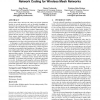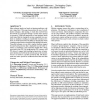6 search results - page 1 / 2 » Code injection attacks on harvard-architecture devices |
CCS
2008
ACM
13 years 6 months ago
2008
ACM
Harvard architecture CPU design is common in the embedded world. Examples of Harvard-based architecture devices are the Mica family of wireless sensors. Mica motes have limited me...
WISEC
2009
ACM
2009
ACM
Practical defenses against pollution attacks in intra-flow network coding for wireless mesh networks
13 years 11 months ago
Recent studies show that network coding can provide significant benefits to network protocols, such as increased throughput, reduced network congestion, higher reliability, and ...
JSA
2007
13 years 4 months ago
2007
— Hardware implementations of cryptographic algorithms are vulnerable to fault analysis attacks. Methods based on traditional fault-tolerant architectures are not suited for prot...
TRUST
2010
Springer
13 years 9 months ago
2010
Springer
Abstract. Recent research demonstrates that adversaries can inject malicious code into a peripheral’s firmware during a firmware update, which can result in password leakage or...
EUROSYS
2006
ACM
14 years 1 months ago
2006
ACM
Many software attacks are based on injecting malicious code into a target host. This paper demonstrates the use of a wellknown technique, data tainting, to track data received fro...


